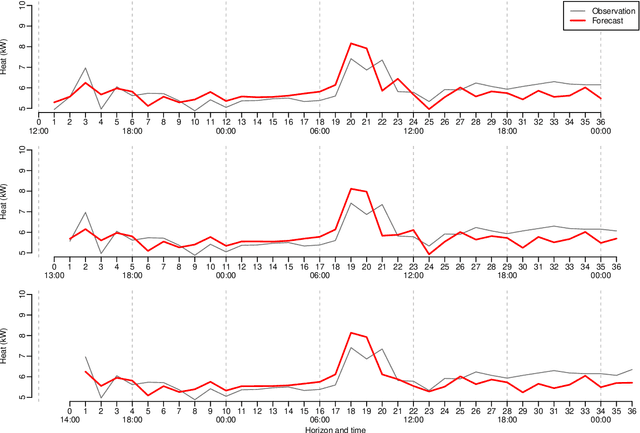Jan Kloppenborg Møller
nabqr: Python package for improving probabilistic forecasts
Jan 29, 2025Abstract:We introduce the open-source Python package NABQR: Neural Adaptive Basis for (time-adaptive) Quantile Regression that provides reliable probabilistic forecasts. NABQR corrects ensembles (scenarios) with LSTM networks and then applies time-adaptive quantile regression to the corrected ensembles to obtain improved and more reliable forecasts. With the suggested package, accuracy improvements of up to 40% in mean absolute terms can be achieved in day-ahead forecasting of onshore and offshore wind power production in Denmark.
Structural hierarchical learning for energy networks
Feb 08, 2023Abstract:Many sectors nowadays require accurate and coherent predictions across their organization to effectively operate. Otherwise, decision-makers would be planning using disparate views of the future, resulting in inconsistent decisions across their sectors. To secure coherency across hierarchies, recent research has put forward hierarchical learning, a coherency-informed hierarchical regressor leveraging the power of machine learning thanks to a custom loss function founded on optimal reconciliation methods. While promising potentials were outlined, results exhibited discordant performances in which coherency information only improved hierarchical forecasts in one setting. This work proposes to tackle these obstacles by investigating custom neural network designs inspired by the topological structures of hierarchies. Results unveil that, in a data-limited setting, structural models with fewer connections perform overall best and demonstrate the coherency information value for both accuracy and coherency forecasting performances, provided individual forecasts were generated within reasonable accuracy limits. Overall, this work expands and improves hierarchical learning methods thanks to a structurally-scaled learning mechanism extension coupled with tailored network designs, producing a resourceful, data-efficient, and information-rich learning process.
Hierarchical learning, forecasting coherent spatio-temporal individual and aggregated building loads
Jan 30, 2023Abstract:Optimal decision-making compels us to anticipate the future at different horizons. However, in many domains connecting together predictions from multiple time horizons and abstractions levels across their organization becomes all the more important, else decision-makers would be planning using separate and possibly conflicting views of the future. This notably applies to smart grid operation. To optimally manage energy flows in such systems, accurate and coherent predictions must be made across varying aggregation levels and horizons. With this work, we propose a novel multi-dimensional hierarchical forecasting method built upon structurally-informed machine-learning regressors and established hierarchical reconciliation taxonomy. A generic formulation of multi-dimensional hierarchies, reconciling spatial and temporal hierarchies under a common frame is initially defined. Next, a coherency-informed hierarchical learner is developed built upon a custom loss function leveraging optimal reconciliation methods. Coherency of the produced hierarchical forecasts is then secured using similar reconciliation technics. The outcome is a unified and coherent forecast across all examined dimensions. The method is evaluated on two different case studies to predict building electrical loads across spatial, temporal, and spatio-temporal hierarchies. Although the regressor natively profits from computationally efficient learning, results displayed disparate performances, demonstrating the value of hierarchical-coherent learning in only one setting. Yet, supported by a comprehensive result analysis, existing obstacles were clearly delineated, presenting distinct pathways for future work. Overall, the paper expands and unites traditionally disjointed hierarchical forecasting methods providing a fertile route toward a novel generation of forecasting regressors.
onlineforecast: An R package for adaptive and recursive forecasting
Sep 27, 2021
Abstract:Systems that rely on forecasts to make decisions, e.g. control or energy trading systems, require frequent updates of the forecasts. Usually, the forecasts are updated whenever new observations become available, hence in an online setting. We present the R package onlineforecast that provides a generalized setup of data and models for online forecasting. It has functionality for time-adaptive fitting of linear regression-based models. Furthermore, dynamical and non-linear effects can be easily included in the models. The setup is tailored to enable effective use of forecasts as model inputs, e.g. numerical weather forecast. Users can create new models for their particular system applications and run models in an operational online setting. The package also allows users to easily replace parts of the setup, e.g. use kernel or neural network methods for estimation. The package comes with comprehensive vignettes and examples of online forecasting applications in energy systems, but can easily be applied in all fields where online forecasting is used.
 Add to Chrome
Add to Chrome Add to Firefox
Add to Firefox Add to Edge
Add to Edge